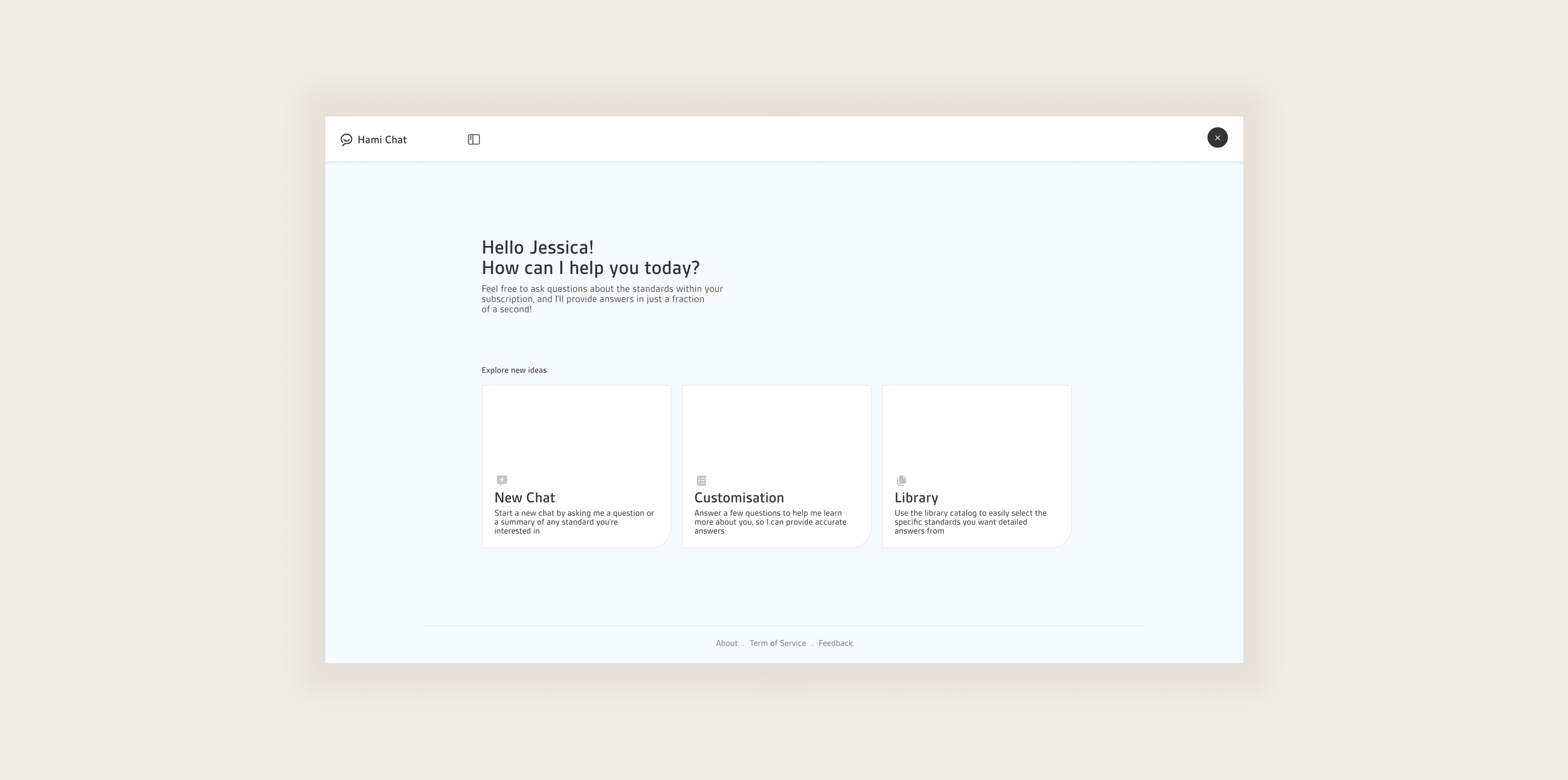Hami Chat
At BSI, I partnered with data scientists and engineers to design Standard Discovery — an AI-powered chat tool that helps users quickly find and interpret standards.
My role went beyond UI/UX design. I:
Designed the chat experience end-to-end, from wireframes to high-fidelity prototypes.
Facilitated workshops with data scientists and engineers to shape implementation.
Introduced business strategies, such as subscription-based upsell mechanisms.
Delivered a full prototype for developer handoff, ensuring smooth translation into build.
Team
2 Data Scientist
2 Engineers
Project manager
My Role
Product Designer
Duration
3 Months
The Challenge
Standards are complex and technical, making them hard for users to navigate. Searching through documents often took hours, and interpreting clauses without guidance was even harder.
Meanwhile, tools like ChatGPT have raised expectations — users now demand instant, conversational answers. But with BSI’s vast library of standards, keyword overlaps made accuracy a real challenge, raising the risk of hallucinations or irrelevant results.
For the business, there was a parallel challenge: building a solution that didn’t just improve user experience but also created economic value and fit the roadmap for AI adoption.
Users
We identified three core personas:
Small business owners / SME managers
Limited resources, need quick, affordable compliance help.Corporate compliance managers
Coordinating global compliance and regulatory audits.Educators & researchers
Using standards to teach and underpin researchAcross all groups, users wanted speed, clarity, and trust.
My Approach
To address both user needs and business goals, I worked in three parallel tracks:
Design Leadership
Created the chat interface and workflows, iterating from sketches → wireframes → high-fidelity prototypes.
Designed the dashboard integration, foldering system, and scoped search filters.
Collaboration & Workshops
Ran workshops with data scientists and engineers to align on how to reduce hallucinations (citations, reliability scores, prompt engineering).
Worked with stakeholders to ensure features aligned with the long-term roadmap.
Business Strategy
Proposed the subscription constraint mechanism: if a user asked about a standard outside their plan, the AI would acknowledge the answer exists but lock access until they upgraded. This created transparency for users and a built-in upsell pathway for the business.
Design & Features I Delivered
Conversational Chat: ChatGPT-style interaction, but tailored for standards.
Reliability Indicators: Every answer included citations and a reliability score.
Personalization: Onboarding questions (industry, company size, role) for tailored responses.
Scoped Search: Users could filter results by subscription library or individual documents.
Foldering System: Saved chats for future reference and organization.
Upsell Mechanism: Subscription constraints turned locked answers into natural upgrade prompts.
Forecasted Impact
Forecasted Impact (Based on Industry Benchmarks)
Efficiency: With AI handling ~50–80% of routine queries, we expect to reduce average search time by 40–60%, freeing up user time and increasing satisfaction.
Engagement: Given high chatbot adoption trends, we anticipate over 60% of logged-in users will try Standard Discovery post-launch.
Business Value: AI-driven upsell moments may boost subscription expansion by an estimated 10–20%, reflecting how chatbot insights can directly influence revenue.
Trust & Retention: Including reliability scoring and citations builds trust, aligning with broader trends showing increased retention and loyalty for AI-supported experiences.
Reflectiont
This project reinforced that trust is the foundation of AI UX. By designing for transparency (citations, reliability scores) and control (scoped search, personalization), users felt empowered rather than misled.
It also showed me how UX can drive business growth. My subscription constraint idea turned a design challenge into a revenue opportunity, strengthening the link between product usability and commercial impact.
Finally, facilitating workshops with data scientists taught me the value of cross-disciplinary collaboration — aligning design vision with technical feasibility early on.
Next steps will focus on user testing, refining the reliability scoring, and expanding personalization features.








